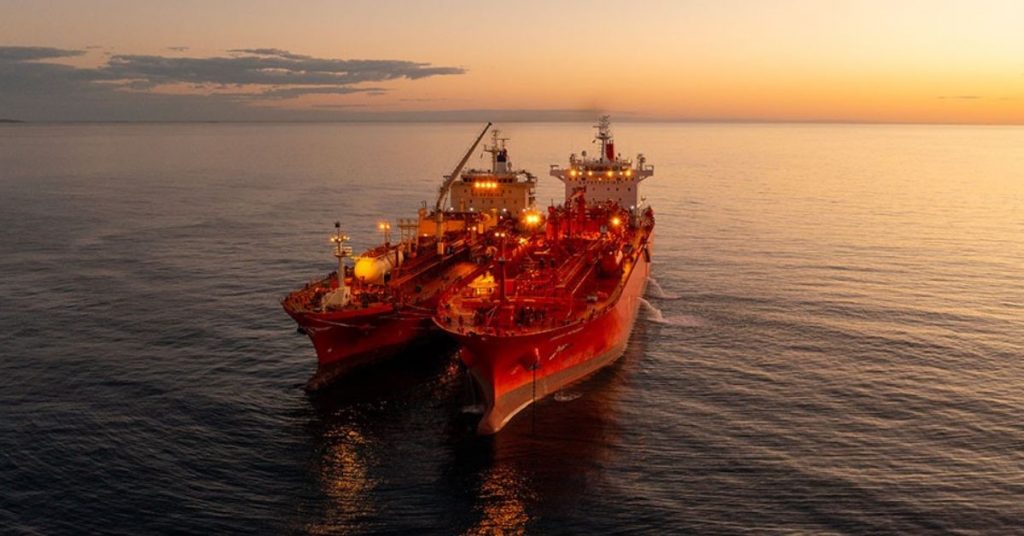The Global Centre for Maritime Decarbonisation (GCMD) has released a detailed report analyzing the outcomes of a successful ship-to-ship liquid ammonia transfer pilot conducted in September 2024. The trial, held 20 nautical miles off the coast of Port Dampier, Western Australia, marks a significant step forward in exploring ammonia’s potential as a zero-carbon marine fuel.
The operation involved transferring 2,700 metric tonnes of liquid ammonia between two gas carriers — the Green Pioneer and the Navigator Global — at a rate of 700 to 800 cubic metres per hour. The site at Western Anchorage WA19 was chosen for its favourable operational conditions, including an existing ammonia terminal, a history of safe ammonia handling, and ample anchorage space far from populated areas.
The report, titled “Path to Zero-Carbon Shipping: Insights from Ammonia Transfer Trial in the Pilbara”, evaluates the technical, safety, logistical, and regulatory considerations of transferring ammonia within a functioning port anchorage. It provides a comprehensive look at operational feasibility while offering guidance for future ammonia bunkering and handling protocols.
Safety Analysis and Operational Findings
The pilot was supported by extensive safety assessments, grouped into four areas: feasibility, risk, consequence, and emergency response. These studies confirmed that ship-to-ship ammonia transfer is achievable under controlled conditions, provided that appropriate safeguards are in place.
A key component of the analysis was a mooring study that drew on data from LNG bunkering operations. It examined 36 sea-state scenarios and concluded that operations can proceed safely with wind speeds up to 20 knots and a swell height of 0.3 metres — limits sufficient to ensure vessel stability and avoid contact between bridge wings.
Additionally, Computational Fluid Dynamics (CFD) plume dispersion modelling simulated an ammonia release scenario involving 33 cubic metres — four times greater than the most credible worst-case event. At wind speeds of 10 m/s, the model projected a dispersion plume up to 750 metres long, remaining within the anchorage’s 1 NM boundary and unlikely to impact nearby vessels.
Risk assessments, including Hazard Identification (HAZID) and Hazard and Operability Study (HAZOP), identified 23 medium-level risks. These were addressed through measures such as Emergency Release Couplings (ERCs), restricting simultaneous operations, and deploying an emergency response vessel.
Emergency preparedness protocols were also thoroughly tested. These included specific communication plans, PPE requirements, designated incident handlers, verified spill kits, and the presence of a firefighting tug. Crew members underwent ammonia-specific drills to ensure readiness.
Looking Ahead
The report also arrives at a pivotal moment for the maritime industry. The International Maritime Organization’s (IMO) adoption of a global emissions pricing framework in April 2025, which links costs to greenhouse gas (GHG) fuel intensities, is expected to increase the appeal of ammonia as a zero-carbon fuel.
Technological advancements are keeping pace: the world’s first two-stroke dual-fuel ammonia engine is slated for deployment in early 2026, signaling the beginning of ammonia-fuelled ship operations. Commenting on the trial, GCMD CEO Professor Lynn Loo noted the significance of pre-emptive guideline development: “Historically, bunkering standards evolved over time with operational experience. In this case, guidelines are being shaped in advance of commercial deployment. This makes comprehensive, real-world trials such as this one crucial in informing safe handling practices and supporting the broader energy transition in shipping.”
Tags: Ammonia Fuel, GCMD, Maritime Decarbonisation, Maritime Innovation, sustainable Shipping, ZeroCarbon Shipping



Recent Posts
Stena Line’s Hybrid Ferry Stena Futura Completes Sea Trials, Set to Boost Irish Sea Freight Capacity
Taiwanese owner makes methanol move with WinGD across multiple engine orders
Econowind installs four VentoFoils on tanker M/T JUTLANDIA SWAN
Global Maritime Groups Unite to Launch Alliance for Electrification of Shipping Sector
India Charts Green Future for Maritime Sector with Hydrogen Hubs and Sustainable Port Strategy
ZeroNorth’s SMARTShip platform integrates with ClassNK MRV portal to automate emissions reporting
Towngas Partners with TLB, Pacific Basin to Advance Green Marine Fuel Infrastructure in Hong Kong
SECI Extends Bid Deadline for Green Ammonia Tender Under SIGHT Scheme